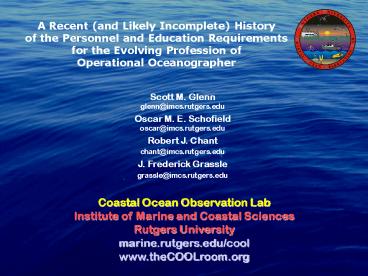A Recent (and Likely Incomplete) History - PowerPoint PPT Presentation
Title:
A Recent (and Likely Incomplete) History
Description:
A Recent (and Likely Incomplete) History of the Personnel and Education Requirements for the Evolving Profession of Operational Oceanographer Scott M. Glenn – PowerPoint PPT presentation
Number of Views:82
Avg rating:3.0/5.0
Title: A Recent (and Likely Incomplete) History
1
A Recent (and Likely Incomplete) History of the
Personnel and Education Requirements for the
Evolving Profession of Operational Oceanographer
Scott M. Glennglenn_at_imcs.rutgers.edu Oscar M. E.
Schofield oscar_at_imcs.rutgers.edu Robert J.
Chant chant_at_imcs.rutgers.edu J. Frederick
Grassle grassle_at_imcs.rutgers.edu
Coastal Ocean Observation Lab Institute of Marine
and Coastal Sciences Rutgers University marine.rut
gers.edu/cool www.theCOOLroom.org
2
A Recent (and Likely Incomplete) History of the
Personnel and Education Requirements for the
Evolving Profession of Operational Oceanographer
- January, 2000 - Almanac for Seapower
- Admiral Richard West
- Navy's Operational Oceanography Program comprised
of more than 3,000 military and civilian
personnel. - 430 Oceanography officers (2 year M.S. degree)
- 1600 Enlisted METOC Specialists (10 week
introduction, 28 week weather forecasting) - 1400 civilian personnel in the naval
oceanographic community - forecasts for weather, aviation flight,
amphibious assault beach, electromagnetic, ocean
acoustic, electro-optic, specific weapon systems
and special operations warfare. - New littoral emphasis while maintaining deep
water proficiency - January, 2000 - Oceanography
- Scott Glenn, Tommy Dickey, Bruce Parker and
Bill Boicourt - Long-term Real-time Coastal Ocean
Observation Networks - Training a new generation of science support
staff - Masters level
- Cross trained in oceanography and computer
science, electronics, or engineering - Sole purpose of graduate education should not be
to produce another Ph.D.
3
- March, 2000 - EOS
- Chris Mooers
- Operational Oceanography Shall We Dance?
- Supported by a highly educated workforce to
maintain, evaluate and upgrade the observing,
modeling and telecommunications systems. - Skilled regional forecasters to combine numerical
guidance with local observations and knowledge - Current operational oceanographers Navy between
100 to 4000 (depending on definition) and about
100 at NOAA. - June, 2000 - EOS
- Richard Spinrad
- Comment on Operational Oceanography Shall
We Dance? - U.S. Navy operational oceanographic community
comprises approximately 2800 individuals
worldwide. - Development of new operational oceanography
capabilities, data acquisition, and product
dissemination. - Includes remotely sensed, in situ and predictive
data from a multitude of sources - July, 2000 - Physics Today
- Toni Feder
- Argo Begins Systematic Global Probing of the
Upper Oceans - Howard Freeland (leader of Canadian Argo effort)
- the primary result of Argo will be the
identification of a new profession - operational
oceanography. - Purely scientific gains pale into insignificance.
Success measured by the quality of the product
supplied, not research papers.
4
- November, 2000 - EOS
- Stan Wilson and Muriel Cole
- Comment on "Operational Oceanography Shall
We Dance?" - 1317 NOAA FTEs in operational oceanography.
- Collect data, derive products, produce analyses
and generate forecasts. - Chris Mooers
- Reply
- Sticking with 4,000 individuals and assuming a 40
year work career, 100 new graduates are needed
each year. - Professional and educational needs should become
planning factors. - Meteorological paradigm is one model
- January, 2001 - Letter from Naval Oceanographic
Office to the Office of Navel Research - Landry Bernard, James Rigney
- Oceanographic Education
- Requirements - Scientists in all of the
subspecialties of oceanic sciences, engineers and
computer scientists. - Challenges in operational oceanography - due to
rapid changes in PO in the last 10 years,
including satellite data and dynamical forecast
models. - Greatest challenge - setting up models in new
areas and assessing forecast quality.
5
- October, 2001 - Letter to James Rigney at
NAVOCEANO. - Robert Lorens
- Operational Oceanography Curricula
- Personal Communication Skills- written and oral
- Computer Communication Skills - Fortran, C,
scripting - Statistics - data errors and limitations
- Numerical Analysis - numerical recipes, analysis
libraries, Matlab, - GIS - ARCVIEW
- Descriptive and Dynamical Oceanography
- Applied Ocean Modeling - model is a black box and
operations are emphasized. - Data Analysis - time series and spectral
- Ocean Acoustics
- Field Experience
- October 2001 - email responses
- Chuck Weigand, NLMOC
- Core oceanography courses - physics, chemistry,
biology and geology. - Basic meteorology
- At sea experience
6
Operational Oceanography Program Requirements
- Rutgers Requirements for Masters without Thesis
- 30 Credits of Course Work (typically ten 3-credit
courses) - Expository Essay Defense
- Typical Course Load
- Summer Fall
Spring - Year 1 Field Experience 3 Courses
3 Courses - Year 2 Field Experience 2 Courses Essay
2 Courses Essay - Year 3 Field Experience
7
Potential Operational Oceanography Courses
Introductory Core Courses Physical
Oceanography Biological Oceanography Chemical
Oceanography Marine Geology Advanced
Physical Oceanography Meteorology Atmosphere
and Ocean Dynamics Coastal and Estuarine
Dynamics Atmospheric Boundary Layers Waves,
Currents Sediment Transport Transport
Processes in Geophysical Environments Graduate
Seminar Observations Modeling Remote
Sensing Geophysical Data Analysis Ocean
Modeling 1 2 Engineering Coastal
Engineering Robotic Systems Engineering Computer
Graphics Virtual Reality Technology
Interdisciplinary Courses Synoptic Meteorology
Ocean Optics Ocean Acoustics
Computer/Math Tools Statistics Numerical
Analysis Techniques Data Visualization Computer
Language - Fortran, C, Java
3 (PO 2) 2 2 1 1 1 ______ 10
8
Whats Missing?
Practical Training in an Operational Environment
- How do we fix this?
- Change in academic philosophy
- Education program linked to an Operational
Observatory - Internships at Government Labs
- Co-ops with Industrial Partners
9
(No Transcript)

